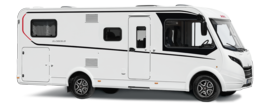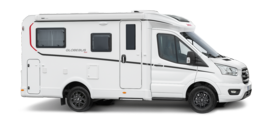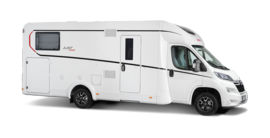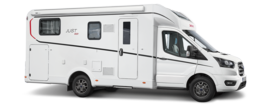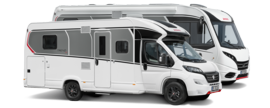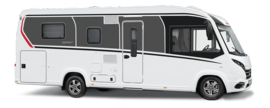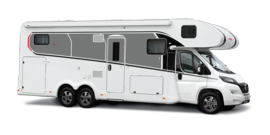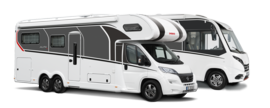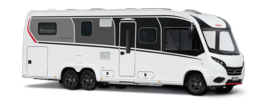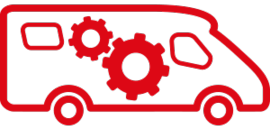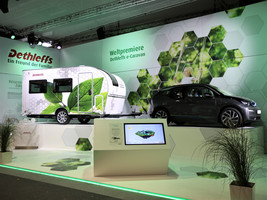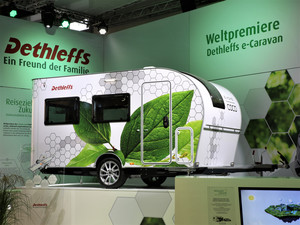From vision to reality
e.home Coco ready for testing
From study to functional prototype – Dethleffs exhibits the next step towards the future at the Caravan Salon – e.home Coco enters the test phase
That which was just a distant vision of the caravan pioneer last year – the idea of an electric caravan that propels itself – is now within reach. At this year’s Caravan Salon, Dethleffs will demonstrate how the e.home Coco study presented last year has been transformed into a fully functional prototype that will tackle the great challenge of crossing the Alps by 2020 at the latest. Over the past 12 months, the manufacturer of leisure vehicles based in Germany’s Allgäu region has done everything in its power to transform the vision of a self-propelled caravan into reality. “We worked very hard on the implementation and are now in prototype stage”, says Dethleffs Product Manager Richard Angerer. “Now we’re entering the test phase. The results will bring us a major step closer to the future of caravanning.” That’s because the self-propelled e.home Coco invalidates the fundamental rules for caravans that have been in force for decades. They are no longer just being towed behind a vehicle and are instead propelling themselves. This reduces the load of the towing vehicle, which also makes longer ranges practical when an electric car is used for towing. Since this innovation not only reinvents the caravan but also trailers in general, there are still a number of fundamental questions to be answered, ranging from driver licence issues to European approval directives.
What is backdrop of the idea of the e.home Coco?
As a friend of the family, Dethleffs embraces the concept of sustainability. “After all, sustainability is all about preserving our natural world for future generations”, explains Dethleffs Managing Director Alexander Leopold. “We see electric drive systems as key to this. With our ‘Destination Future – Electromobility in Caravanning’ initiative, we are promoting projects that will help us make progress in this area in a targeted manner. The e.home Coco demonstrates today that the caravan has an exciting future even in an era of electric cars. In addition, the technology exhibited in the e.home Coco also represents an unparaleled leap forward in innovation in combination with towing vehicles with conventional internal combustion engines, because this technology makes it possible for small cars to pull heavy trailers for the first time.”
What does the e.home Coco have that other caravans don’t?
The short answer for those outside the industry would be “an electric drive system”. However, this answer would in no way do justice to the complexity and innovative power behind the overall concept of e.home Coco. “The e.home Coco demonstrates the path from pure caravan to self-propelled ‘caravan vehicle’ and reinterprets Arist Dethleffs’s 1931 invention in a completely new way”, explains Richard Angerer. “Its technology and the idea behind this vehicle concept are revolutionising caravanning and are also milestones in the field of electromobility in our industry”, Angerer says. The company is certain that electric cars will come, but what will caravanning of the future look like? The e.home Coco demonstrates how it can work.
How does the e.home Coco accomplish this?
Equipped with high-performance batteries, a central drive unit with two electric motors and intelligent control electronics, the passive trailer will be transformed into an active caravan vehicle. The e.home Coco’s towing load reduction module is of particular importance. It precisely controls the two electric drive motors so that the towing load on the coupling head of the towing vehicle is reduced to a defined value – of 100 kg, for example. This makes it possible for small towing vehicles to tow heavy (caravan) trailers whose total mass is far above the permissible towing capacity of the passenger car. Practical travel ranges are thus achieved in combination with an electric passenger car as the towing vehicle. On downhill stretches, the batteries can be recharged by means of recuperation.
In addition, the e.home Coco increases driving safety through targeted, wheelspecific power distribution. A central control unit continuously evaluates all vehicle dynamics data and controls the drive unit individually for each wheel on this basis. The first driving simulations in cooperation with the Research Institute for Automotive Engineering and Motors (FKFS) in Stuttgart have shown that this drive concept has a positive influence on trailer handling.
The individually addressable drive unit of the e.home Coco also enables manoeuvring, including up to 360 degrees of rotation on the spot. For example, a mobile device could be used to conveniently park the e.home Coco on the campsite.
Why is an extensive test phase so important?
“We are breaking completely new ground with the e.home Coco”, explains Angerer. “For this trailer drive concept, there are still no safety standards to which we could adhere and no particular scheme to follow for a testing sequence. That’s why we are taking guidance from automotive industry standards, according to the strict specifications of which we have developed the e.home Coco.” Automotive safety standards are known to be quite high, which also led to Dethleffs to make improvements in comparison to the study such as by designing and reinforcing the prototype chassis in accordance with the latest safety aspects in order to protect important components in the event of a collision.
After the Caravan Salon, the Allgäu-based manufacturer is to begin with various system tests of the individual components, taking into account the special demands placed on the vehicle. Once everything has been checked and any adjustments have been made, the individual components are brought together and further tests are carried out. The e.home Coco will then be put through its paces again on various routes and test tracks. The absolute endurance test will take place in the final step, which is to take place in fiscal year 2019/2020: the journey over the Alps.
Challenges for the future
We’ll start with the good news: almost everything that motorhome and caravan manufacturer Dethleffs imagined in its vision could be transformed into reality. “Some things went much easier than we thought, but there were also many difficult challenges to overcome,” reports Richard Angerer in regard to the arduous work of recent months. Even though there is now a fully functional prototype in Düsseldorf, that doesn’t mean that all challenges have been met. Despite the great effort that Dethleffs has put into the project, there are still outstanding issues that the company has not been able to resolve on its own. One very important problem to be solved is attainment of approval for the self-propelled trailer, as this vehicle category does not yet exist. “Another important issue is the driver licence question”, Angerer explains. “The e.home Coco can reduce its towing load so that I can tow it with a small towing vehicle, with the towing load reduction module bringing the towing load down to just 100 kg. The question here is: “Do I still need a special driver licence, and if so, what category?” These and other challenges are being discussed and solutions are being initiated in Germany’s Federal Association for Electric Mobility (BEM), which the Erwin Hymer Group recently became a member of. “We are active in the BEM working group ‘eMobility & Trailers’, which deals precisely with such questions. Together with the relevant authorities, we will also find solutions for this issue”, Angerer asserts.
Another challenge is additional use of the e.home Coco as a mobile power storage device. The idea behind the overall concept is that the caravan will also be used in everyday life, supplied with power from the photovoltaic system on the roof of the home. “We imagined this implementation would be easier – and it is more difficult not because it cannot work but because there is still a need for clarification in various respects”, Angerer admits. “However, this would distract us too much from our actual work, namely the manufacture of leisure vehicles. That’s why we’re relying on good lobbying and support from the BEM on this issue as well.”
